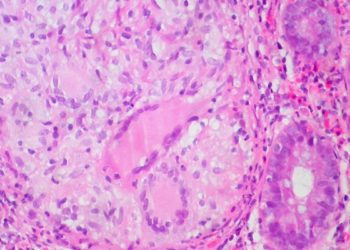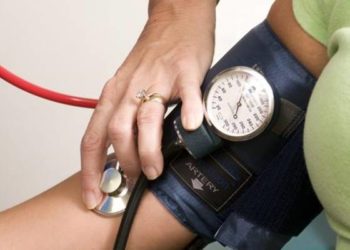2 Minute Medicine Rewind February 27, 2023
Evaluation of Maternal Infection During Pregnancy and Childhood Leukemia Among Offspring in Denmark
1. In a Danish cohort, maternal genitourinary tract infection during pregnancy was associated with an increased risk of childhood leukemia in offspring
Evidence Rating Level: 2 (Good)
Little is known about the etiology of leukemia. Previous studies have reported that childhood leukemia may originate in utero, with cytokine levels at birth different for healthy children compared to those who developed leukemia in childhood. It is thought that maternal infection can lead to chromosomal and immunological alterations which could be a risk factor for childhood leukemia. Previous systematic reviews and meta-analyses have found that maternal influenza, rubella, and varicella during pregnancy were associated with a higher risk of childhood leukemia, but the evidence from these studies originated predominantly from case-control studies. This population-based cohort study used data from all live births in Denmark between 1978 and 2015, including a total of 222,277 children. Maternal infection was identified using the Danish National Patient Registry based on inpatient and outpatient diagnoses and these infections were characterized by site. The primary outcome of the study was a diagnosis of leukemia in the children and secondary outcomes of acute lymphoid leukemia (ALL) and acute myeloid leukemia (AML). Compared to children born to mothers without infection (adjusted hazard ratio [HR], 1.35 [95% CI, 1.04-1.77]), children born to mother with infection during pregnancy had a 35% increased risk of leukemia, with maternal genital and urinary tract infections associated with a 142% and 65% increased risk respectively (HRs of 2.42 (95% CI, 1.50-3.92) and 1.65 (95% CI, 1.15-2.36). Associations were not observed for other infections such as respiratory tract and digestive infections. This study has limitations including that data was extracted from hospital diagnoses, potentially missing milder infections and infections not treated in healthcare facilities. Additionally, outpatient infection data was only available from 1995 onwards. Overall, this study suggests that maternal urinary and genital tract infections during pregnancy are associated with a higher risk of childhood leukemia. Future studies on the etiology of childhood leukemia, and those examining mild infections and other factors are needed, with additional studies aimed at developing preventive measures.
Serum hsCRP in early pregnancy and preterm delivery in twin gestations: a prospective cohort study
1. In a cohort of pregnant women in Beijing, elevated high-sensitivity C-reactive protein (hsCRP) was associated with increased risk of preterm delivery in twin gestations
Evidence Rating Level: 2 (Good)
Preterm delivery (PTD) is related to high infant morbidity and mortality in twin gestations, with the risk of PTD being up to 56.6% in twin gestations. PTD can be spontaneous PTD (sPTD), or medical induced PTD (mPTD), accounting for 60-70% and 30-40% of PTD respectively. The etiology of sPTD is multifactorial including mechanisms such as inflammation and uteroplacental ischemia. C-reactive protein (CRP) is a biomarker in response to inflammation, and high-sensitive CRP (hs-CRP) can reflect low-grade inflammation. Studies in the past have found elevated maternal CRP or hsCRP was associated with an increased risk of sPTD but limited studies have involved twin gestations. This study involved 618 twin gestations from a tertiary hospital in Beijing, with serum samples collected from early pregnancy analyzed for hsCRP. 48.87% were classified as PTD. The adjusted analysis showed a serum hsCRP higher in PTDs compared to term deliveries (2.13 mg/L, 95% confidence interval [CI] 2.09 –2.16 vs (1.84 mg/L, 95% CI 1.80 –1.88) (P < 0.001). The highest tertile of hsCRP was associated with increased risk of PTD compared to the lowest tertile. High values of serum hsCRP in early pregnancy were associated with preterm deliveries in the subgroup of spontaneous preterm deliveries (ARR 1.49, 95%CI:1.08–1.93). Limitations to the study include difficulty generalize results as 85.2% of participants were nulliparous. Additionally, serum hsCRP was measured during the first trimester with no values for the second and third trimesters. Overall, this study found that hsCRP was positively associated with increased risk of sPTD among twin gestations, indicating that inflammatory changes in early pregnancy may influence timing of labour. Future studies investigating more inflammatory markers, and those examining markers from each trimester as well as studies including multiparous patients are needed to continue to investigate and mitigate risk factors for PTD.
1. Antibiotic stewardship interventions safely reduced antibiotic prescribing for frail older adults with suspected urinary tract infections.
Evidence Rating Level: 1 (Excellent)
Inappropriate antibiotic use is an important contributor to antibiotic resistance. Older adults are often inappropriately prescribed antibiotics for non-specific symptoms of suspected urinary tract infections. Current guidelines recommend being restrictive with antibiotic prescribing when specific urinary tract symptoms are absent, however implementation of these guidelines in practice is challenging. This study evaluated whether a multifaceted antibiotic stewardship intervention was effective in reducing antibiotic prescribing for suspected urinary tract infections in various older adult care settings across four European countries. This randomized controlled trial involved 1041 frail adults, defined as those 70 year or older, with physical or mental disabilities, or both, dependency in activities of daily living, no use of prophylactic antibiotics, not receiving hospice care and not estimated to have a very limited life expectancy. Over 38 clusters consisting of one or more general practices and older adult care organizations were included in the study. Clusters were assigned as intervention or usual care stratified by country and cluster size. The providers in the intervention cluster received the multifaceted antibiotic stewardship intervention, and those in the control cluster were told they were participating in research on urinary tract infections. The primary outcome was the number of antibiotic prescriptions for suspected urinary tract infections per person year, with secondary outcomes including the incidence of complications. Those in the intervention group had a lower rate of receiving antibiotic prescription for suspected urinary tract infections compared to the usual care group, with a rate ratio of 0.42 (95% confidence interval 0.26 to 0.68). Between both groups, no differences were seen in the incidence of complications. Limitations to this study include the lack of blinding due to the nature of the study. Additionally, data on antibiotic prescriptions for other indications was not collected. The study was also over a seven-month follow-up period, making it difficult to evaluate the sustainability of the results. Finally, the study was conducted over the COVID-19 pandemic, when antibiotic use was lower in general. Overall, this study indicates that the implementation of an antibiotic stewardship intervention reduced antibiotic prescribing for suspected urinary tract infections in frail older adults, with no impact on the rate of complications. Future studies examining the sustainability of the results, as well as studies focusing on other indications for antibiotics are needed to help with future guidelines for antibiotic stewardship.
1. Low household income is associated with higher 21-gene recurrence scores (score based on gene expression signatures that indicated risk of distant metastasis) and significantly worse survival outcomes among those with scores below 26 for ER positive breast cancer.
2. Income levels not associated with surgical outcomes when 21-gene recurrence scores were 26 or higher.
Evidence Rating Level: 2 (Good)
Low socioeconomic status (SES) is a risk factor for unfavorable breast cancer outcomes. Previous studies have found that low income is associated with a higher incidence of triple negative breast cancer, however the relationship between low income and 21-gene recurrence score (RS) for patients with estrogen receptor (ER)-positive breast cancer is unknown. RS is a score based on gene expression signatures indicating the risk of distant metastasis, ranging from 0 to 100 with RS of 25 or below indicating non-high risk and RS above 25 indicating high risk. This observational cohort study evaluated the association of income levels with RS and overall survival (OS) for those with nonmetastatic ER-positive breast cancer. The study included 119 478 women, 68.8% of whom had high income (above the median household income of $50 353) and 31.2% had low income (below the median household income of $50 353). Compared to high income, low income was associated with a higher RS (adjusted odds ratio [aOR], 1.11; 95% CI, 1.06-1.16) and low income was also associated with worse OS (adjusted hazards ratio [aHR], 1.18; 95% CI, 1.11-1.25). For those with RS of 26 or higher, no significant OS differences were found between income levels. Limitations to this study include its retrospective nature, as certain relevant variables were unavailable for analysis. Additionally, only a small proportion of patients had high RS, and the subgroup analysis may have been inadequately powered to detect differences within the subgroup. Overall, this study indicates that low household income is associated with higher RS and worse survival outcomes among those with RS below 26. Future studies investigating various other social determinants of health and tumour biology may help provide further information on the various determinants of breast cancer outcomes.
1. In pediatric patients between the age of 0 to 16, those on VA-ECMO have a high proportion and early occurrence of infections, potentially prolonging duration of VA-ECMO support and PICU LOS.
Evidence Rating Level: 2 (Good)
Veno-arterial Extra-Corporeal Membrane Oxygenation (VA-ECMO) is a standard therapy in refractory cardiovascular failure. The use of VA-ECMO puts patients at risk for many complications, including nosocomial infections which occur at a frequency between 16 to 42%. Limited studies reviewing nosocomial infections related to ECMO in pediatric patients have been conducted in the past. This retrospective study aimed to determine the frequency, timing and factors associated with nosocomial infections in children on VA-ECMO support. This study included 41 patients between the ages of 0 to 16 years on VA-ECMO support for more than 6 hours, for those who required multiple uses of VA-ECMO, the first use was considered. The first PICU infection was defined as a positive microbiological sample with clinical signs of infection or clinical signs of severe infection without a positive sample. 24%of the patients developed an infection, with a median time to first infection being 4 days and Pseudomonas spp. being the most commonly detected organism. Longer PICU stay (greater than 14 days) and longer VA-ECMO support (>5 days) was associated with infection (OR 12 (95% CI 2.2–65.5; p = 0.004 and OR 5.9 (CI 95% 1.4–24.6; p = 0.01 respectively). Limitations to this study include the inability to rule out any infections that may have been present prior to ECMO initiation. Additionally, the study involved a small number of patients at a specific local practice, making results difficult to generalize. Finally, it is not known of other patients on the unit developed nosocomial infections. Overall, this study indicates that pediatric patients treated with VA-ECMO are at high risk of early nosocomial infection, and these infections were associated with longer VA-ECMO support and PICU stay. Future studies are needed to continue to understand the nature of nosocomial infections in pediatric populations on VA-ECMO supports, as well as ways to prevent and manage these infections.
Image: PD
©2023 2 Minute Medicine, Inc. All rights reserved. No works may be reproduced without expressed written consent from 2 Minute Medicine, Inc. Inquire about licensing here. No article should be construed as medical advice and is not intended as such by the authors or by 2 Minute Medicine, Inc.






